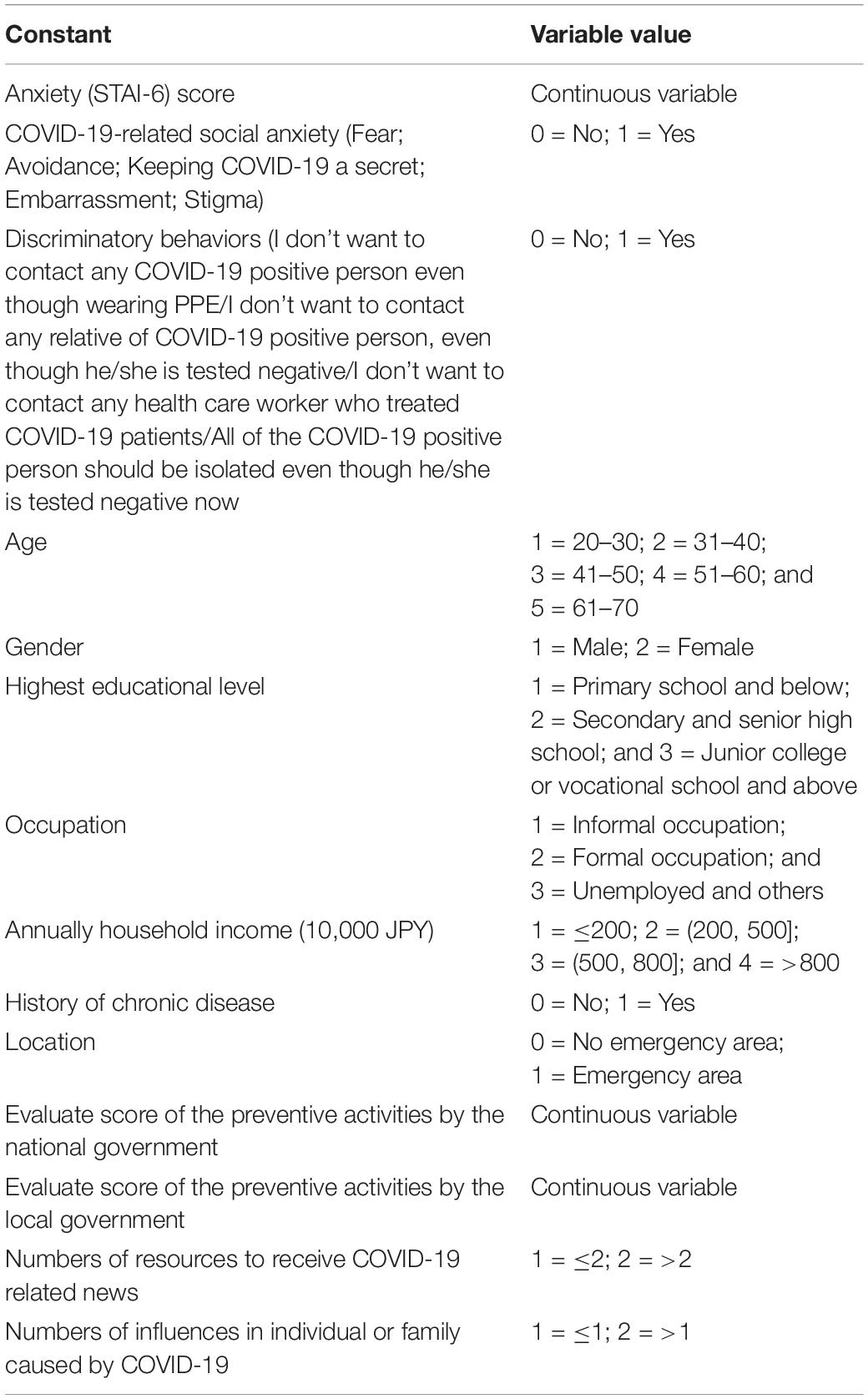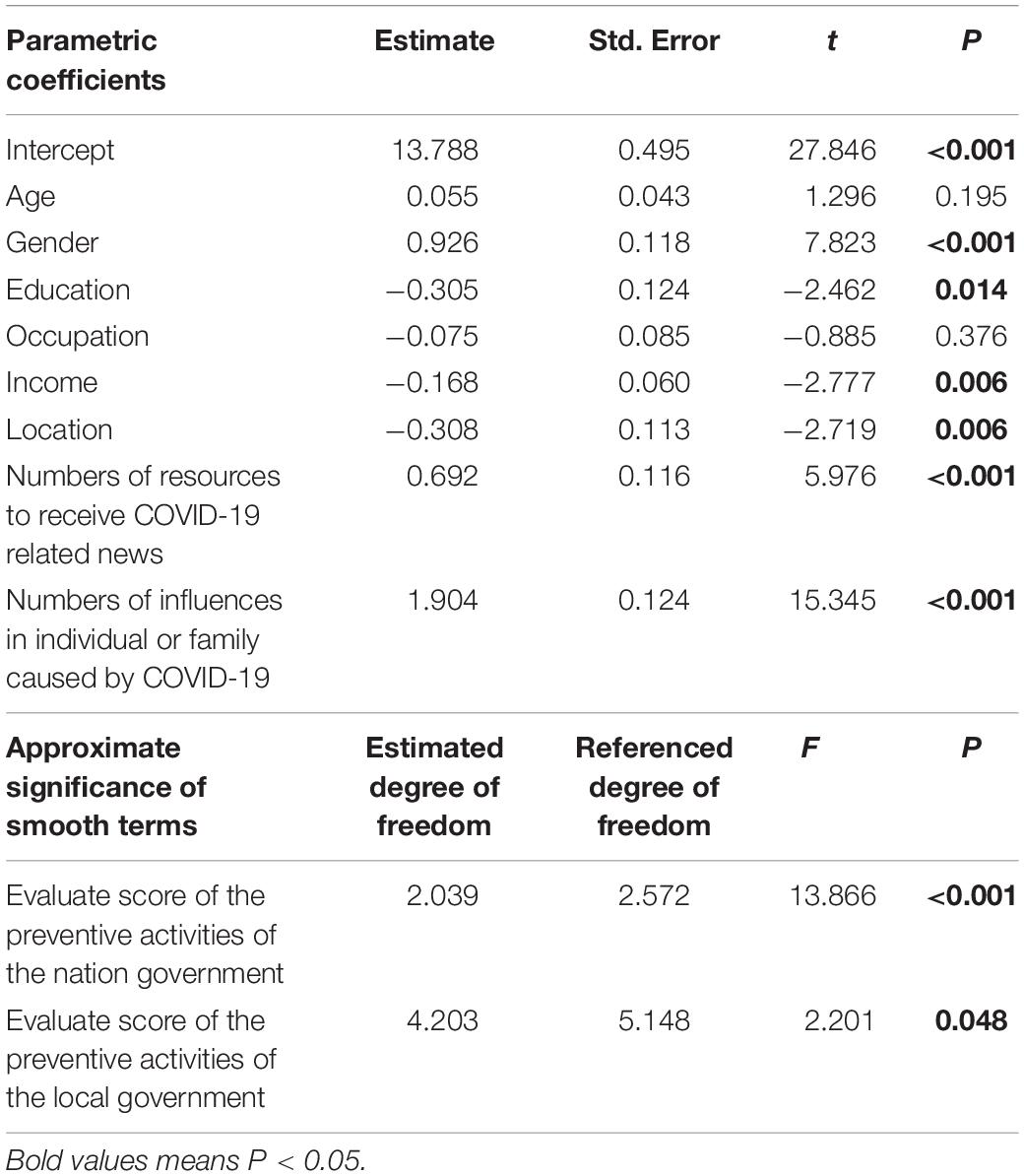- 1Fujian Provincial Key Laboratory of Environment Factors and Cancer, Department of Epidemiology and Health Statistics, School of Public Health, Fujian Medical University, Fuzhou, China
- 2Department of Public Health, Nagasaki Prefectural Institute of Environment and Public Health, Nagasaki, Japan
- 3Department of International Health, Institute of Tropical Medicine (NEKKEN), Nagasaki University, Nagasaki, Japan
- 4Department of Public Health, Nagasaki University Graduate School of Biomedical Sciences, Nagasaki, Japan
- 5Centre for Epidemiology and Evidence-Based Practice, Department of Social and Preventive Medicine, Faculty of Medicine, Universiti Malaya, Kuala Lumpur, Malaysia
- 6Department of Virology, Institute of Tropical Medicine (NEKKEN), Nagasaki University, Nagasaki, Japan
Background and Objectives: Anxiety plays an important role in psychology. An exploration of anxiety and its associated reactions may provide insight into measures for addressing mental health problems caused by the coronavirus disease 2019 (COVID-19) pandemic. Data from this study provide potential correlational responses to anxiety.
Methods: A cross-sectional study using data collected via an online self-reported questionnaire was conducted in Japan during the COVID-19 pandemic. Using the State-Trait Anxiety Inventory (STAI-6), we assessed anxiety levels and explored the relationship between anxiety STAI-6 score, sources of COVID-19 information, the influences of COVID-19, social anxiety symptoms, discrimination, and evaluation of the government.
Results: A total of 4,127 participants were included in the analysis. The level of anxiety was not equally distributed across the general population with respect to age, gender, educational level, occupation, income, presence of underlying disease, and location (p < 0.05). The number of sources of information on COVID-19 had a positive correlation with the STAI-6 score (Spearman’s rho = 0.176, p < 0.001). The influence of the pandemic was correlated with moderate–severe anxiety. A high level of anxiety added to social anxiety (Spearman’s rho = 0.04, p < 0.05) and discriminatory behavior (Spearman’s rho = 0.11, p < 0.01). Being female (Estimate = 0.926) and from a non-emergency area (Estimate = −0.308) was related to higher STAI scores, and higher education (Estimate = −0.305), and income (Estimate = −0.168) decreased the STAI score. The respondents who had a lower evaluative score of the preventive activities undertaken by the national and local governments had higher STAI-6 scores.
Conclusion: Our findings provide statistical evidence for the associated reaction of anxiety and that anxiety reactions may vary in predictable ways. Further studies should focus on the strategic interventions that may decrease the associated responses to anxiety, to address mental health issues due to the pandemic.
Introduction
The role of psychology in healthcare has significantly expanded in recent years. Anxiety level is a key indicator of mental health (Horenstein and Heimberg, 2020); persistent moderate to severe anxiety symptoms can have a negative impact on psychological health (Labrague and De Los Santos, 2020).
Due to the coronavirus disease 2019 (COVID-19) pandemic, dramatic changes to normal life emerged in many countries. The general population experienced psychological distress, especially anxiety, during the pandemic (Liu X. et al., 2020; Wang et al., 2020). Individuals with high-level anxiety were found to be vulnerable to changes in harmless bodily sensations as they are affected by the circumstances of COVID-19 (Asmundson and Taylor, 2020). A recently published manuscript in Nature showed that anxiety among graduate students in the United States rose by 50% during the pandemic compared with the previous year (Woolston, 2020). Therefore, anxiety is an important concern during an epidemic.
Excessive online searching for health-related information was found to be anxiety-provoking (McMullan et al., 2019). Furthermore, different information sources related to the COVID-19 pandemic contributed differently to responses to the outbreak (Cui et al., 2020). Also, anxiety itself was a reason for excessive searching for pandemic-related information (Vai et al., 2020). Importantly, social anxiety is marked by fear or anxiety of possible scrutiny by others in social situations (Heimberg et al., 2014). Therefore, the accumulation of individual anxiety may trigger a series of social anxiety symptoms (Ng-Cordell et al., 2018). It was noted that trust is beneficial to reducing anxiety (Flugelman et al., 2020; Jhang, 2020); in other words, anxiety may add distrust regarding relevant departments. A previous study showed that a lower level of anxiety was associated with trust in the healthcare system (AlRuthia et al., 2020). Further, a high level of anxiety may contribute to the increased possibility of being affected by a public health emergency (Tull et al., 2020) and the influences of a pandemic may in turn increase the anxiety. Thus, there may be certain unidentified factors that add to anxiety and cause a ripple effect.
The COVID-19 outbreak has spread to countries worldwide in a very short duration. In Japan, the seven most affected prefectures were Saitama, Chiba, Tokyo, Kanagawa, Osaka, Hyogo, and Fukuoka. Japan announced a state of national emergency and these counties were defined as emergency areas, while the rest of the country was defined as a non-emergency area. The general public suffered psychological distress during the COVID-19 pandemic (Sasaki et al., 2020; Shigemura et al., 2020). Therefore, we assessed the factors related to anxiety and the associated responses to the COVID-19 pandemic. These data may be used to develop and implement the emotional regulation control strategies in Japan.
The previous studies suggested that anxiety may cause psychological and behavioral changes, but few studies have assessed the associated reactions to anxiety, especially during a pandemic. In this study, we used a six-item state version of the State-Trait Anxiety Inventory (STAI-6) – a self-report psychological test for adults designed to measure feelings of immediate anxiety and the level of anxiety (Sydeman, 2018). We aimed to investigate the anxiety symptoms in the general public during the COVID-19 pandemic in Japan and explore reactions related to anxiety. We explored the relationship between STAI-6 Score, sources of COVID-19-related information, the influences of COVID-19, social anxiety symptoms, discrimination, and evaluation of the government.
Materials and Methods
Study Design
A cross-sectional web-based survey was adopted via an online market research company, Cross Marketing Inc. Japan1 (Shiina et al., 2021) between May 12 and 13, 2020 in Japan. The survey included a pool of approximately 2 million (the total population of Japan is 127 million) registered individuals. We used quota sampling to attain an equal gender and age distribution representative of the Japanese population, based on statistics from the Labor Force Survey and Ministry of Internal Affairs and Communications. The monetary incentive was provided to participants who completed the survey. We sent the survey link to 5,610 individuals and a total of 4,134 participants responded to the questionnaire. After data cleaning (the respondents with logically inconsistent answers were excluded), 4,127 complete responses were analyzed in this study (Cai et al., 2021).
Questionnaire Design
This study consisted of questions on: (1) demographic characteristics (such as, age, gender, education, occupation, income, location, and with or without underlying disease); (2) individual anxiety; (3) sources of information on COVID-19-related news; (4) influences on individuals or their family from the COVID-19 pandemic; (5) social anxiety related to COVID-19; (6) discrimination related to COVID-19; and (7) evaluation score regarding the preventive activities undertaken by the national and local governments.
To assess individual anxiety levels related to the COVID-19 pandemic, the STAI-6 was used (Knight et al., 1983). This scale contains six items and four choices (1 = not at all, 2 = somewhat, 3 = moderately, and 4 = very much) that reflect common symptoms of anxiety experienced by an individual. The scores on the three positively worded items were reverse-coded, a higher score corresponded to a higher level of individual anxiety. STAI-6 is a simplified version of STAI-20, and the total summed scores were prorated (multiplied by 20/6) to obtain scores that were comparable to those from the full 20-item STAI (Knight et al., 1983; Marteau and Bekker, 1992).
The question on COVID-19 information sources was multiple choice and included TV, radio, government authorities, internet or social network service (SNS), newspaper, family, or friends. We used a self-report method to explore the influences of COVID-19 (increase in family quarrels and conflicts; weakening of social connections; increased intake of alcohol; increased smoking; increase in sexual harassment or violence; sleep quality affected; becoming nervous toward people around you; people around you became nervous and anxious; gained weight). Participants could choose more than one answer in the last item (included the impact on individuals and families).
The section on social anxiety consisted of five items that included fear, avoidance, keeping secrets, embarrassment, and stigma. The acts of discrimination contained feelings of not wanting to be in contact with anyone related to COVID-19, even though they were not contagious. There were four answer options in the section on social anxiety and discrimination in the original questionnaire, and we simplified the answers to “Yes” (Strongly agree and Agree) and “No” (Strongly disagree and Disagree). A scoring system was adopted to evaluate the preventive measures taken by the national and local governments. The scores ranged from 0 to 100, with higher scores indicating a higher evaluation of the government. All the variable values in our study are shown in Table 1.
Ethical Considerations
This study was conducted with the approval of the Research Ethics Committee of Nagasaki Prefectural Institute of Environment and Public Health (No. 2020-6-1). Participants were informed that their participation was voluntary and they had the option to withdraw from the survey at any time before their participation. We used an online consent which was in accordance with the Declaration of Helsinki and approved by the ethics committee to obtain the informed consent of participants. The data are completely anonymous.
Data Analysis
Means, frequencies, and SDs were used to quantify the data. We use Student’s t-test, F-test, and rank-sum test to identify differences in STAI-6 score in individuals with different demographic backgrounds. The sources of COVID-19 related information, social anxiety and discrimination related to COVID-19 were correlated to the STAI-6 score using the Spearman’s correlation test. We used a generalized additive model to analyze the factors of anxiety and evaluate the score of preventive activities by the national and local governments and their correlation with the STAI-6 score. Chi-square (χ2) was used to identify the relationship between individual anxiety and influences on individuals or their families. All the analyses also contained subgroup analyses stratified by type of emergency region. Data were analyzed using R software version 4.0.2 for Windows 10. Excel 2019 was used to draw figures.
Results
Demographic Characteristics and State-Trait Anxiety Inventory Score
There were 2,187 respondents from emergency areas and 1,940 respondents from non-emergency areas. The STAI score was range 6–24 (95% CI = 17.461–17.695). The differences in the mean STAI-6 scores were statistically significant regarding age, gender, highest educational level, occupation, income, underlying disease, and location (p < 0.05). Participants [annual household income was 200–500 (10,000 JPY)] from non-emergency areas had a higher mean STAI-6 score compared to participants in emergency areas (after Bonferroni correction). The detailed characteristics and STAI-6 scores of the participants are presented in Table 2.
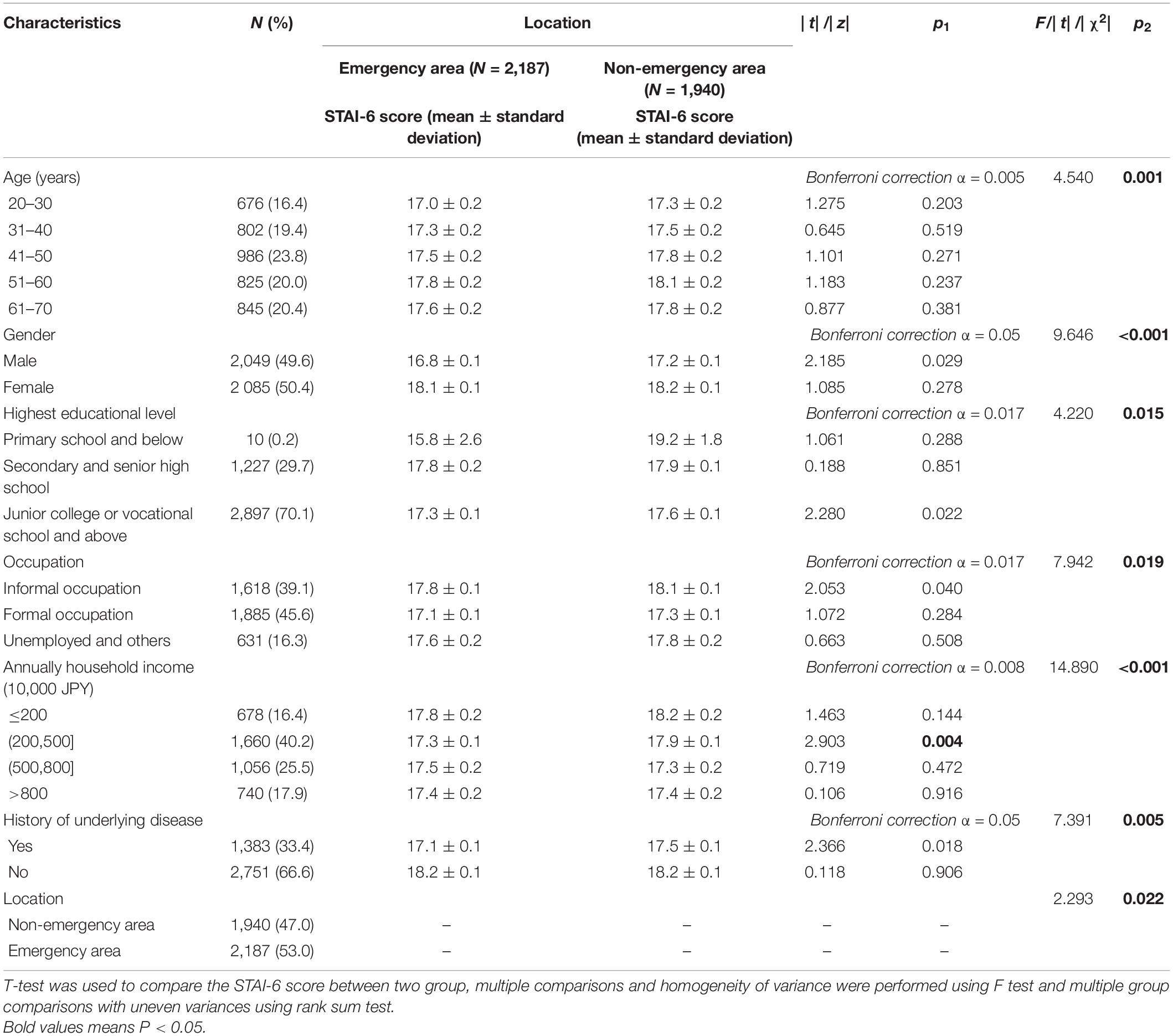
Table 2. Demographic characteristics of participants and State-Trait Anxiety Inventory (STAI) score (N = 4,127).
Sources of Information and State-Trait Anxiety Inventory Score
The differences in sources of COVID-19-related news in different locations are shown in Figure 1. The number of participants from non-emergency areas that got information related to COVID-19 from the Newspaper (p < 0.01) and family or friends (p < 0.05) was larger than respondents from emergency areas. The number of sources of information on COVID-19 was positively correlated with the STAI-6 score (Spearman’s rho = 0.176, p < 0.001; Figure 2). Different locations also showed the same result (emergency area: Spearman’s rho = 0.166, p < 0.001; non-emergency area: Spearman’s rho = 0.186, p < 0.001).
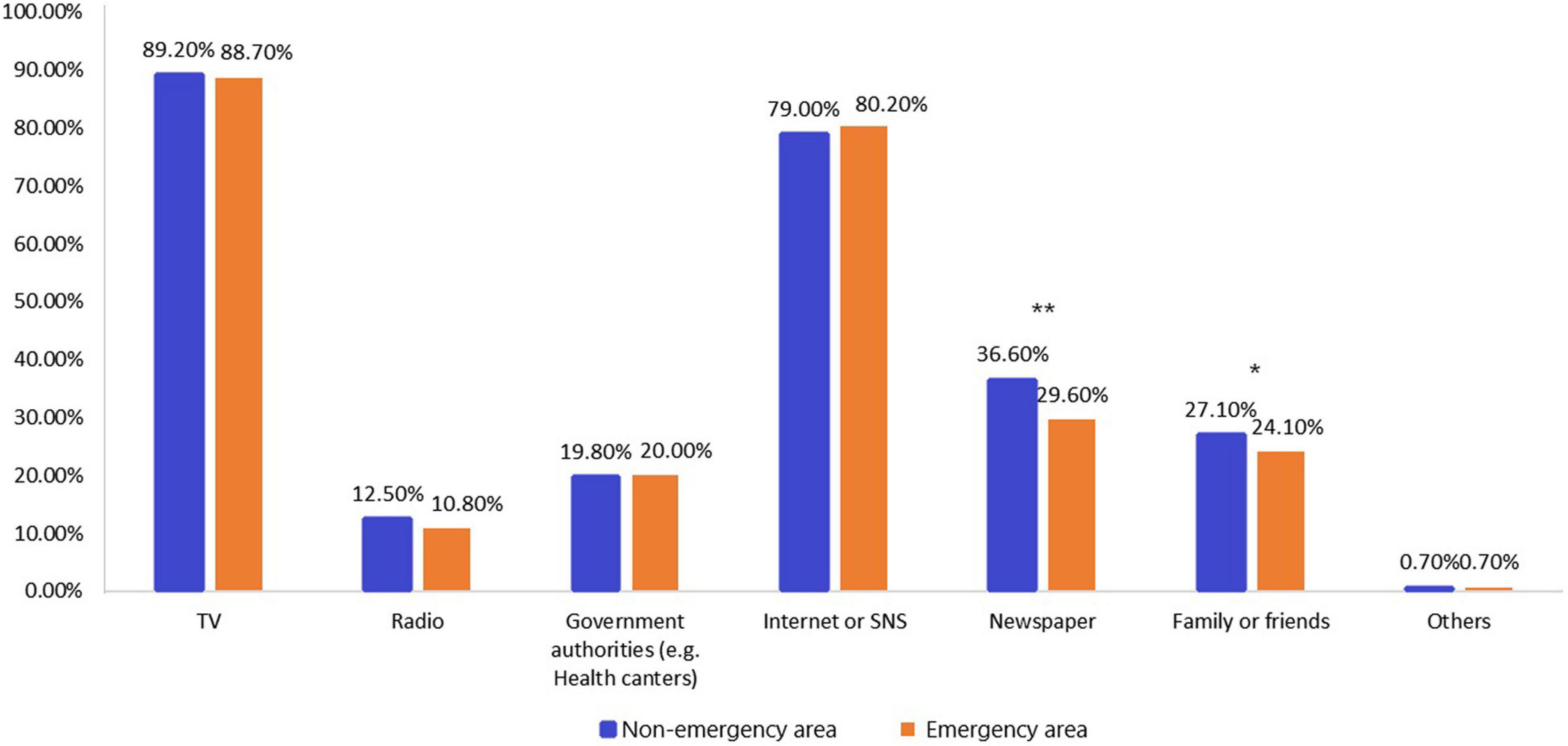
Figure 1. Sources of information for participants in different locations to receive coronavirus disease 2019 (COVID-19)-related news. *P < 0.05; **P < 0.01.
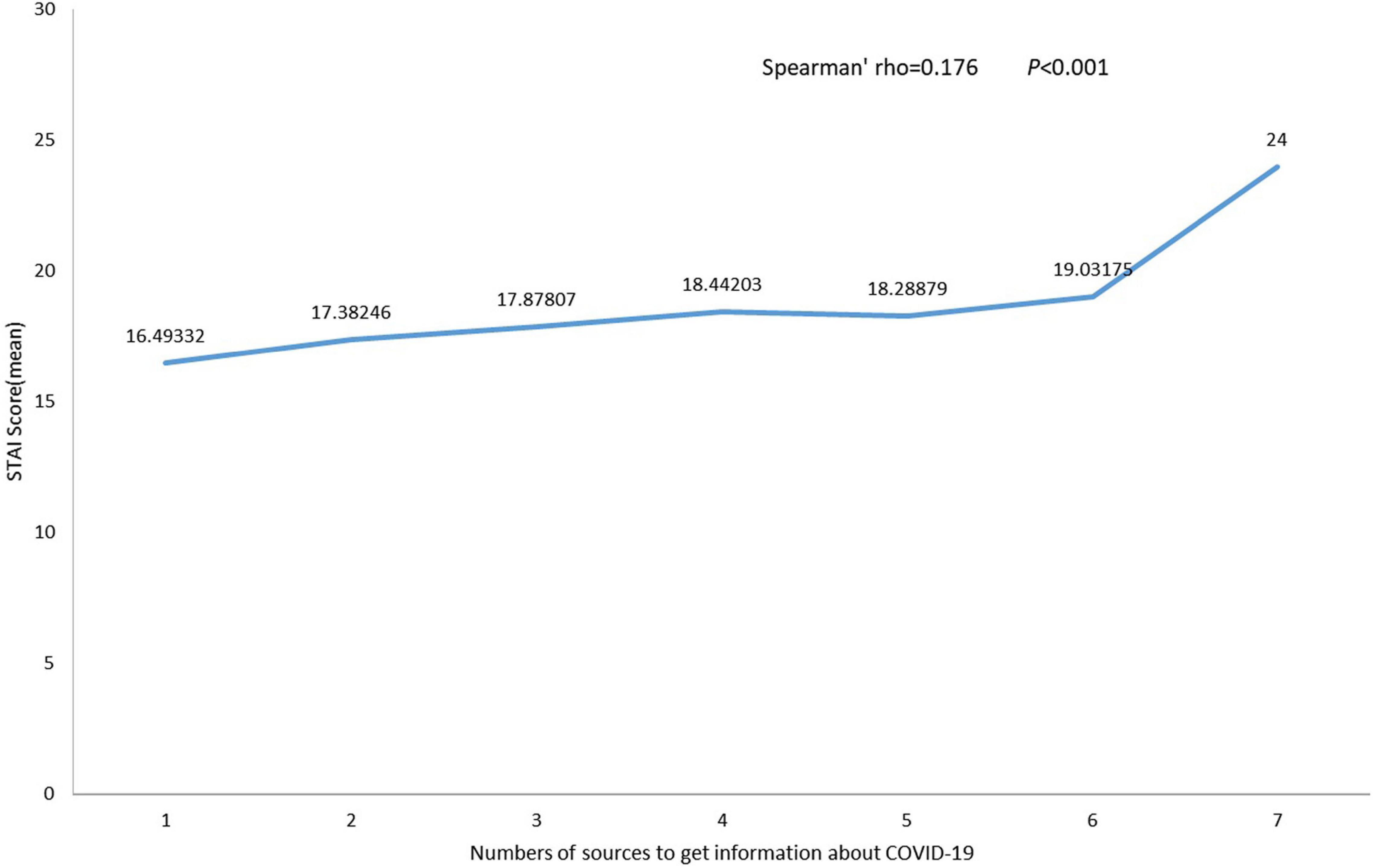
Figure 2. The relationship of State-Trait Anxiety Inventory-6 (STAI-6) score and numbers of sources to get information about the COVID-19.
Influences of Coronavirus Disease 2019 and Individual Anxiety
Figure 3 shows the differences in COVID-19 pandemic influences between different locations and the relationship of these influences on individual anxiety. Participants with influences, such as weakened social connections, increased alcohol intake, increased smoking, sleep quality affected, and gained weight were more frequently from emergency areas (p < 0.05). The respondents that experienced an increase in family quarrels and conflicts, weakened social connections, sleep quality affected, increase in stress, became nervous toward people around them, and people around me became nervous and anxious were more likely to indicate moderate to severe individual anxiety symptoms (p < 0.05).

Figure 3. The situation of COVID-19 epidemic influence the participants or their family and the relation of moderate to severe anxiety symptoms. P1 means the significance of the differences in COVID-19 epidemic influences between different location; P2 means the significance of the differences in the incidence of moderate to severe anxiety symptoms amongst participants with or without COVID-19 epidemic influences (The influences included increase in family quarrels and conflicts; weakening of social connections; increased intake of alcohol; increased smoking; increase in sexual harassment or violence; sleep quality affected; becoming nervous toward people around you; people around you became nervous and anxious; gained weight).
Social Anxiety, Discriminatory, and State-Trait Anxiety Inventory Score
The summary of social anxiety and discrimination related to COVID-19 in different locations is shown in Table 3. In all participants, there were positive correlations between the number of social anxiety symptoms, the number of discriminatory behaviors, and the STAI-6 score. Specifically, increased number of social anxiety symptoms and discriminatory behaviors were associated with increased STAI-6 scores. Participants from non-emergency areas had similar results. While in emergency areas, there was no correlation between the STAI-6 score and the number of social anxiety symptoms (Figure 4).
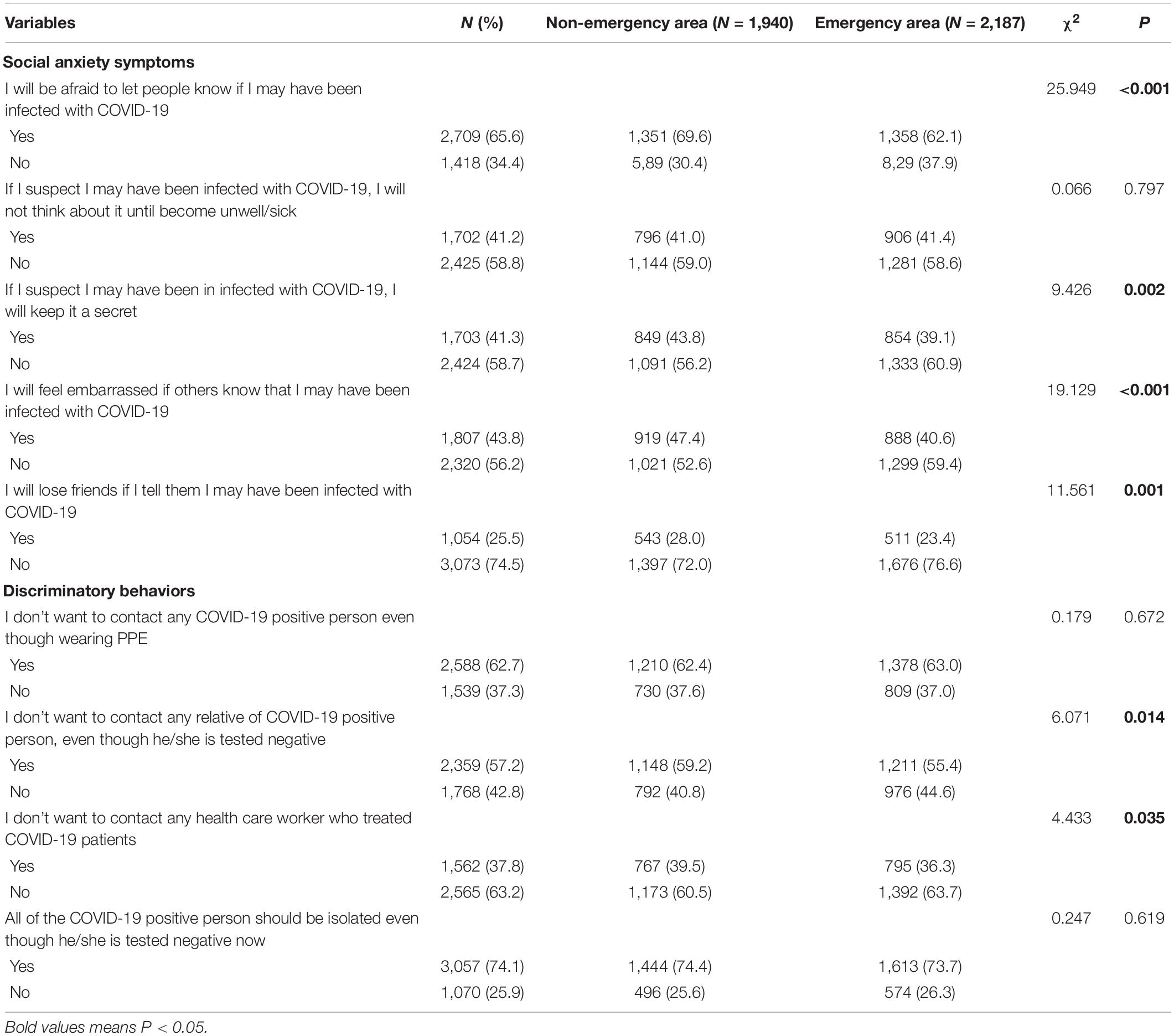
Table 3. Differences of social anxiety symptoms and discriminatory behaviors related to the coronavirus disease 2019 (COVID-19) between different locations.

Figure 4. The relationship between STAI-6 score and numbers of social anxiety symptom and discriminatory behavior related to COVID-19. S1 = STAI-6 Score; S2 = Numbers of social anxiety symptom; S3 = Numbers of discriminatory behavior related to COVID-19. *P < 0.05; **P < 0.01.
Factors Associated With State-Trait Anxiety Inventory Score in the Generalized Additive Model
The generalized additive model included age, gender, education, occupation, income, location, number of resources for COVID-19 related news, number of influences on individual or family caused by COVID-19, an evaluative score of the preventive activities undertaken by the national and local governments as independent variables, and the STAI-6 score as a dependent variable. Being female (Estimate = 0.926) and from a non-emergency area (Estimate = −0.308) was related to higher STAI scores, and higher education (Estimate = −0.305) and income (Estimate = −0.168) decreased the STAI score. The respondents who had a lower evaluative score of the preventive activities undertaken by the national and local governments had higher STAI-6 scores (p < 0.05; Table 4 and Figure 5).
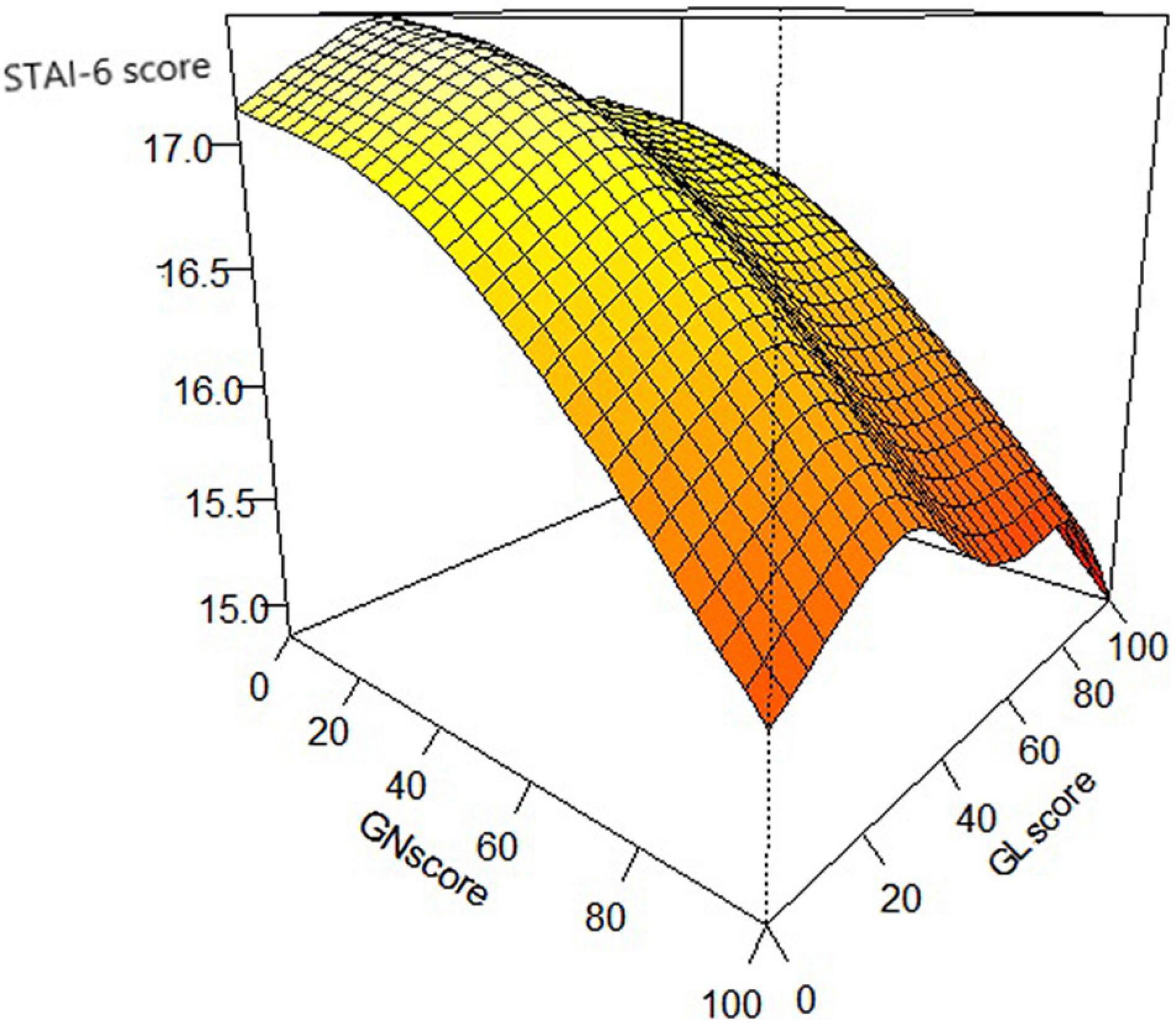
Figure 5. The evaluate score of governments affecting the STAI-6 score. GN Score = Evaluate score of the preventive activities by the national government; GL Score = Evaluate score of the preventive activities by the local government.
Discussion
Our study provided insight into the reactions related to individual anxiety during the COVID-19 pandemic. Higher access to information regarding COVID-19 increased anxiety and influences related to COVID-19 added the possibility of moderate to severe anxiety symptoms. The increased level of anxiety may lead to social anxiety symptoms, discriminatory behaviors. And distrust in the government also related to anxiety. In addition, we suspect that a high level of anxiety may increase the possibility of being affected by the COVID-19 pandemic.
To date, numerous studies have explored anxiety in the general public, health workers, teachers, students, and patients with certain diseases during the ongoing COVID-19 pandemic. These studies can be broadly divided into three categories. The first category of risk factors (such as, sociodemographic factors, online social media information, and knowledge of COVID-19) related to anxiety, has been studied the most (Jo et al., 2020; Jungmann and Witthöft, 2020; Liu C. et al., 2020; Yang et al., 2021). The second type of study focused on the effects of interventions on anxiety caused by the COVID-19 pandemic (Chen, 2020; Liu K. et al., 2020; Wei et al., 2020); interventions mainly consist of relaxation techniques like breathing relaxation training and progressive muscle relaxation. The instructions for these interventions were audio-recorded and put online, and the researchers assessed anxiety before and after the intervention. Physical activity is also an intervention, and moderate physical activity during the COVID-19 pandemic has the proven benefit of resulting in a more positive mental state and decreased anxiety (Reigal et al., 2021). The third type focused on how anxiety influences daily life, and behavior changes caused by anxiety were common among the general public during the COVID-19 pandemic (Stanton et al., 2020). In addition, studies on anxiety related to work efficiency were mainly conducted in a certain type of worker (Sasaki et al., 2020), while investigations on patients in hospitals explored changes in somatic function due to anxiety (Speth et al., 2020). To our knowledge, there are few studies focused on well-known anxiety-associated reactions during the COVID-19 pandemic. Our findings provide a clear, serial response to anxiety and offer informative implications for addressing psychological problems during a pandemic.
In our investigation, anxiety was not equally distributed across the general population with respect to age, gender, education level, occupation, income, history of underlying disease, and location. These results were in accordance with a recent national investigation in Japan (Qian and Yahara, 2020).
During the pandemic, people were instructed to stay at home, particularly in emergency areas, and sources of COVID-19 related information played a central role in understanding the status of the pandemic. Our study found that the two highest sources of information were TV and the internet or SNS. The number of responders from non-emergency areas who got information from the newspaper and family or friends was higher in emergency areas. These findings are consistent with current precautionary measures taken by Japan.
Indeed, acquiring information from various sources can add to fear and generate anxiety (Jones and Salathé, 2009). In this study, the number of resources for COVID-19 information and anxiety level had a strong, positive correlation in both emergency and non-emergency areas, confirming the hypothesis that getting numerous messages about a pandemic increased anxiety. A report conducted in Russia found that excessive media consumption about COVID-19 was related to anxiety (Nekliudov et al., 2020), which confirms that consuming a large amount of relevant information can increase anxiety related to COVID-19.
Concerning the influence of the COVID-19 pandemic on individuals or their families, we found that the respondents from emergency areas were more likely to be affected by the pandemic. Therefore, we speculated that during the period that people had to stay at home, family quarrels and conflicts may have increased and social connections had become weaker. Due to the diminution of social intercourse, people became nervous toward others and thought that others were nervous too. They also felt that stress increased and sleep quality was affected. In addition, COVID-19 was related to anxiety symptoms, and our present study shows that the people who were more vulnerable to the effects of a pandemic were more likely to have moderate to severe individual anxiety. During the earlier severe acute respiratory syndrome (SARS) pandemic, researchers found that people experiencing the pandemic felt more stress (McAlonan et al., 2007) and fear (Leung et al., 2005), and were more prone to anxiety. The same reaction was found in our study of the COVID-19 pandemic and proves the feasibility of our research.
Social anxiety and discriminatory behaviors have been prevalent during this pandemic (Choi et al., 2020; Zheng et al., 2020). Our findings indicated that social anxiety symptoms and discriminatory behaviors may be the result of a high level of individual anxiety. Further, these factors may interact, meaning that social anxiety can increase discriminatory behaviors. A previous study on immigrants suggested that perceived discrimination increased social anxiety symptoms (Fang et al., 2016). Our study is the first to discuss individual discriminatory behaviors and social anxiety symptoms. The results showed that people who discriminated against COVID-19 positive people or relevant health workers suffered from more social anxiety symptoms. We used the generalized additive model to explore the relationship between trust in governments (national and local) and anxiety. Findings indicated that accounting for the effect of different regions, participants with a lower evaluation of the government’s preventive measures had a higher level of anxiety. These findings are consistent with other studies showing that trust and anxiety have a negative predictive relationship (Zwingmann et al., 2017; Pamela et al., 2019).
During an infectious disease pandemic, people may change and modify their behavior to adapt and achieve their needs (Reigal et al., 2020). Our investigation showed that impacts from the COVID-19 outbreak increased the likelihood of anxiety. We suspected that people with higher levels of anxiety were more influenced by the COVID-19 pandemic. Previous reports showed that individuals with high anxiety were more affected by disease or public health emergencies (Asmundson and Taylor, 2020; Yang et al., 2020), and that anxiety added to the possibility of being affected by a pandemic, which confirmed our hypothesis.
This study had some limitations. First, as this was an online investigation, participants who did not use the internet were not included, which may limit the generalizability of the results. The questionnaire was designed for the public, and questions for specific groups (such as those who tested positive for COVID-19) were not included. In addition, self-report questionnaires contained recall bias and may be influenced by social desirability biases. Moreover, it is difficult to infer causal relationships from cross-sectional studies. Thus, studies employing multiple follow-up assessments are needed to characterize anxiety and its related reactions. Lastly, the correlation effect was small in our study, which may be because psychological changes are not obvious, and prospective studies are needed to verify these findings. Despite the limitations, our internet-based sampling strategy was quickly deployed and could thereby track responses in near real-time and a large sample size with varied demographic backgrounds. Additionally, we used a standardized questionnaire (STAI-6) to diagnose anxiety, which supported the viability of the data. These findings provide insight into anxiety and related responses during a pandemic.
Conclusion
The current study was the first to provide evidence for the association between anxiety and increased access to information on COVID-19. Additionally, the outbreak and distrust in the government added to anxiety, and a high level of anxiety increased social anxiety, discriminatory behaviors, while anxiety may increase the possibility of remaining under the influence of COVID-19. Our findings may aid psychologists by providing new knowledge on anxiety and serve as a critical step in developing a strategic plan to address the later dimensions of anxiety due to a pandemic. Furthermore, these findings may be generalized to other diseases or traumatic events.
Data Availability Statement
The raw data supporting the conclusions of this article will be made available by the authors, without undue reservation.
Ethics Statement
The studies involving human participants were reviewed and approved by the Research Ethics Committee of Nagasaki Prefectural Institute of Environment and Public Health (No. 2020-6-1). The participants provided their written informed consent to participate in the study.
Author Contributions
GC and FH designed the study. JZ, GC, YLu, XX, and YLi wrote the original draft of the manuscript. YLu, YLi, and GC contributed to the investigation. JZ and FH analyzed the data. LW, ZH, TY, KM, and KA contributed to the interpretation of the results. XX modified the format. All authors reviewed the manuscript and approved the submitted version.
Funding
This work was supported by the Nagasaki Prefectural Research Project (grant number 2020FY-NIEP), JSPS KAKENHI (grant number JP19K24679), and Fujian Program for Outstanding Young Researchers in University awarded by the Education Department of Fujian (grant number 2017B019).
Conflict of Interest
The authors declare that the research was conducted in the absence of any commercial or financial relationships that could be construed as a potential conflict of interest.
Publisher’s Note
All claims expressed in this article are solely those of the authors and do not necessarily represent those of their affiliated organizations, or those of the publisher, the editors and the reviewers. Any product that may be evaluated in this article, or claim that may be made by its manufacturer, is not guaranteed or endorsed by the publisher.
Footnotes
References
AlRuthia, Y., Alwhaibi, M., Almalag, H., Almosabhi, L., Almuhaya, M., Sales, I., et al. (2020). The relationship between trust in primary healthcare providers among patients with diabetes and levels of depression and anxiety. PLoS One 15:e0239035. doi: 10.1371/journal.pone.0239035
Asmundson, G., and Taylor, S. (2020). How health anxiety influences responses to viral outbreaks like COVID-19: what all decision-makers, health authorities, and health care professionals need to know. J. Anxiety Disord. 71:102211. doi: 10.1016/j.janxdis.2020.102211
Cai, G., Lin, Y., Lu, Y., He, F., Morita, K., Yamamoto, T., et al. (2021). Behavioural responses and anxiety symptoms during the coronavirus disease 2019 (COVID-19) pandemic in Japan: a large scale cross-sectional study. J. Psychiatr. Res. 136, 296–305. doi: 10.1016/j.jpsychires.2021.02.008
Chen, S. (2020). An online solution focused brief therapy for adolescent anxiety during the novel coronavirus disease (COVID-19) pandemic: a structured summary of a study protocol for a randomised controlled trial. Trials 21:402. doi: 10.1186/s13063-020-04355-6
Choi, S., Hong, J., Kim, Y., and Park, H. (2020). Predicting psychological distress amid the COVID-19 pandemic by machine learning: discrimination and coping mechanisms of korean immigrants in the U.S. Int. J. Environ. Res. Public Health 17:6057. doi: 10.3390/ijerph17176057
Cui, T., Yang, G., Ji, L., Zhu, L., Zhen, S., Shi, N., et al. (2020). Chinese residents’ perceptions of COVID-19 during the pandemic: online cross-sectional survey study. J. Med. Internet Res. 22:e21672. doi: 10.2196/21672
Fang, K., Friedlander, M., and Pieterse, A. (2016). Contributions of acculturation, enculturation, discrimination, and personality traits to social anxiety among Chinese immigrants: a context-specific assessment. Cultur. Divers. Ethnic Minor. Psychol. 22, 58–68. doi: 10.1037/cdp0000030
Flugelman, M. Y., Jaffe, R., Luria, G., and Yagil, D. (2020). Trust in the referring physician reduces anxiety in an integrated community-to-hospital care system. Isr. J. Health Policy Res. 9:7. doi: 10.1186/s13584-020-00365-6
Heimberg, R., Hofmann, S., Liebowitz, M., Schneier, F., Smits, J., Stein, M., et al. (2014). Social anxiety disorder in DSM-5. Depress. Anxiety 31, 472–479. doi: 10.1002/da.22231
Horenstein, A., and Heimberg, R. (2020). Anxiety disorders and healthcare utilization: a systematic review. Clin. Psychol. Rev. 81:101894. doi: 10.1016/j.cpr.2020.101894
Jhang, F. (2020). Changes in trust and trait anxiety: the mediating role of changes in self-rated health among older adults in Taiwan. Geriatr. Gerontol. Int. 20, 833–838. doi: 10.1111/ggi.13981
Jo, W., Lee, J., Park, J., and Kim, Y. (2020). Online information exchange and anxiety spread in the early stage of the novel coronavirus (COVID-19) outbreak in South Korea: structural topic model and network analysis. J. Med. Internet Res. 22:e19455. doi: 10.2196/19455
Jones, J., and Salathé, M. (2009). Early assessment of anxiety and behavioral response to novel swine-origin influenza A(H1N1). PLoS one 4:e8032. doi: 10.1371/journal.pone.0008032
Jungmann, S., andWitthöft, M. (2020). Health anxiety, cyberchondria, and coping in the current COVID-19 pandemic: which factors are related to coronavirus anxiety? J. Anxiety Disord. 73:102239. doi: 10.1016/j.janxdis.2020.102239
Knight, R., Waal-Manning, H., and Spears, G. (1983). Some norms and reliability data for the state–trait anxiety inventory and the zung self-rating depression scale. Br. J. Clin. Psychol. 22, 245–249. doi: 10.1111/j.2044-8260.1983.tb00610.x
Labrague, L., and De Los Santos, J. (2020). COVID-19 anxiety among front-line nurses: predictive role of organisational support, personal resilience and social support. J. Nurs. Manag. 28, 1653–1661. doi: 10.1111/jonm.13121
Leung, G. M., Ho, L. M., Chan, S. K., and Ho, S. Y. (2005). Longitudinal assessment of community psychobehavioral responses during and after the 2003 outbreak of severe acute respiratory syndrome in Hong Kong. Clin. Infect. Dis. 40, 1713–1720. doi: 10.1086/429923
Liu, C., Yang, Y., Zhang, X., Xu, X., Dou, Q., Zhang, W., et al. (2020). The prevalence and influencing factors in anxiety in medical workers fighting COVID-19 in China: a cross-sectional survey. Epidemiol. Infect. 148:e98. doi: 10.1017/s0950268820001107
Liu, K., Chen, Y., Wu, D., Lin, R., Wang, Z., and Pan, L. (2020). Effects of progressive muscle relaxation on anxiety and sleep quality in patients with COVID-19. Complement. Ther. Clin. Pract. 39:101132. doi: 10.1016/j.ctcp.2020.101132
Liu, X., Luo, W., Li, Y., Li, C., Hong, Z., Chen, H., et al. (2020). Psychological status and behavior changes of the public during the COVID-19 epidemic in China. Infect. Dis. Poverty 9:58. doi: 10.1186/s40249-020-00678-3
Marteau, T., and Bekker, H. (1992). The development of a six-item short-form of the state scale of the Spielberger State-Trait Anxiety Inventory (STAI). Br. J. Clin. Psychol. 31, 301–306. doi: 10.1111/j.2044-8260.1992.tb00997.x
McAlonan, G., Lee, A., Cheung, V., Cheung, C., Tsang, K., Sham, P., et al. (2007). Immediate and sustained psychological impact of an emerging infectious disease outbreak on health care workers. Can. J. Psychiatry 52, 241–247. doi: 10.1177/070674370705200406
McMullan, R., Berle, D., Arnáez, S., and Starcevic, V. (2019). The relationships between health anxiety, online health information seeking, and cyberchondria: systematic review and meta-analysis. J. Affect. Disord. 245, 270–278. doi: 10.1016/j.jad.2018.11.037
Nekliudov, N., Blyuss, O., Cheung, K., Petrou, L., Genuneit, J., Sushentsev, N., et al. (2020). Excessive media consumption about COVID-19 is associated with increased state anxiety: outcomes of a large online survey in Russia. J. Med. Internet Res. 22:e20955. doi: 10.2196/20955
Ng-Cordell, E., Hanley, M., Kelly, A., and Riby, D. (2018). Anxiety in williams syndrome: the role of social behaviour, executive functions and change over time. J. Autism Dev. Disord. 48, 796–808. doi: 10.1007/s10803-017-3357-0
Pamela, Q., Kévin, N., Oliver, B., and Stéphane, B. (2019). The effect of exposure to fear-related body odorants on anxiety and interpersonal trust toward a virtual character. Chem. Senses 9, 683–692. doi: 10.1093/chemse/bjz063
Qian, K., and Yahara, T. (2020). Mentality and behavior in COVID-19 emergency status in Japan: influence of personality, morality and ideology. PLoS One 15:e0235883. doi: 10.1371/journal.pone.0235883
Reigal, R. E., Páez-Maldonado, J. A., Pastrana-Brincones, J. L., Morillo-Baro, J. P., Hernández-Mendo, A., and Morales-Sánchez, V. (2021). Physical activity is related to mood states, anxiety state and self-rated health in COVID-19 lockdown. Sustainability 13:5444.
Reigal, R., Pastrana-Brincones, J., González-Ruiz, S., Hernández-Mendo, A., Morillo-Baro, J., and Morales-Sánchez, V. (2020). Use of data mining to determine usage patterns of an online evaluation platform during the COVID-19 pandemic. Front. Psychol. 11:588843. doi: 10.3389/fpsyg.2020.588843
Sasaki, N., Kuroda, R., Tsuno, K., and Kawakami, N. (2020). Workplace responses to COVID-19 associated with mental health and work performance of employees in Japan. J. Occup. Health 62:e12134. doi: 10.1002/1348-9585.12134
Shigemura, J., Ursano, R., Morganstein, J., Kurosawa, M., and Benedek, D. (2020). Public responses to the novel 2019 coronavirus (2019-nCoV) in Japan: mental health consequences and target populations. Psychiatry Clin. Neurosci. 74, 281–282. doi: 10.1111/pcn.12988
Shiina, A., Niitsu, T., Kobori, O., Idemoto, K., Hashimoto, T., Sasaki, T., et al. (2021). Perception of and anxiety about COVID-19 infection and risk behaviors for spreading infection: an international comparison. Ann. Gen. Psychiatry 20:13. doi: 10.1186/s12991-021-00334-6
Speth, M., Singer-Cornelius, T., Oberle, M., Gengler, I., Brockmeier, S., and Sedaghat, A. (2020). Mood, anxiety and olfactory dysfunction in COVID-19: evidence of central nervous system involvement? Laryngoscope 130, 2520–2525. doi: 10.1002/lary.28964
Stanton, R., To, Q., Khalesi, S., Williams, S., Alley, S., Thwaite, T., et al. (2020). Depression, anxiety and stress during COVID-19: associations with changes in physical activity, sleep, tobacco and alcohol use in Australian adults. Int. J. Environ. Res. Public Health 17:4065. doi: 10.3390/ijerph17114065
Sydeman, S. (2018). “State-trait anxiety inventory,” in Encyclopedia of Personality and Individual Differences, eds V. Zeigler-Hill and T. Shackelford (Cham: Springer). doi: 10.1007/978-3-319-28099-8_950-1
Tull, M., Barbano, A., Scamaldo, K., Richmond, J., Edmonds, K., Rose, J., et al. (2020). The prospective influence of COVID-19 affective risk assessments and intolerance of uncertainty on later dimensions of health anxiety. J. Anxiety Disord. 75:102290. doi: 10.1016/j.janxdis.2020.102290
Vai, B., Cazzetta, S., Ghiglino, D., Parenti, L., Saibene, G., Toti, M., et al. (2020). Risk perception and media in shaping protective behaviors: insights from the early phase of COVID-19 Italian outbreak. Front. Psychol. 11:563426. doi: 10.3389/fpsyg.2020.563426
Wang, H., Xia, Q., Xiong, Z., Li, Z., Xiang, W., Yuan, Y., et al. (2020). The psychological distress and coping styles in the early stages of the 2019 coronavirus disease (COVID-19) epidemic in the general mainland Chinese population: a web-based survey. PLoS One 15:e0233410. doi: 10.1371/journal.pone.0233410
Wei, N., Huang, B., Lu, S., Hu, J., Zhou, X., Hu, C., et al. (2020). Efficacy of internet-based integrated intervention on depression and anxiety symptoms in patients with COVID-19. J. Zhejiang Univ. Sci. B 21, 400–404. doi: 10.1631/jzus.B2010013
Woolston, C. (2020). Signs of depression and anxiety soar among US graduate students during pandemic. Nature 585, 147–148. doi: 10.1038/d41586-020-02439-6
Yang, L., Yu, Z., Xu, Y., Liu, W., Liu, L., and Mao, H. (2020). Mental status of patients with chronic insomnia in China during COVID-19 epidemic. Int. J. Soc. Psychiatry 66, 821–826. doi: 10.1177/0020764020937716
Yang, X., Zhang, Y., Li, S., and Chen, X. (2021). Risk factors for anxiety of otolaryngology healthcare workers in Hubei province fighting coronavirus disease 2019 (COVID-19). Soc. Psychiatry Psychiatr. Epidemiol. 56, 39–45. doi: 10.1007/s00127-020-01928-3
Zheng, L., Miao, M., Lim, J., Li, M., Nie, S., and Zhang, X. (2020). Is lockdown bad for social anxiety in COVID-19 Regions? A national study in the SOR perspective. Int. J. Environ. Res. Public Health 17:4561. doi: 10.3390/ijerph17124561
Keywords: anxiety, COVID-19, STAI-6, mental health, associate response
Citation: Zhuang J, Cai G, Lu Y, Xu X, Lin Y, Wong LP, Hu Z, Yamamoto T, Morita K, Aoyagi K and He F (2022) Exploring Factors and Associate Responses for Anxiety in the Coronavirus Disease 2019 Pandemic: A Web-Based Survey in Japan. Front. Psychol. 12:795219. doi: 10.3389/fpsyg.2021.795219
Received: 15 October 2021; Accepted: 27 December 2021;
Published: 08 March 2022.
Edited by:
Le Shi, Peking University Sixth Hospital, ChinaReviewed by:
Zheng-An Lu, Peking University Sixth Hospital, ChinaAntonio Hernández-Mendo, University of Malaga, Spain
Copyright © 2022 Zhuang, Cai, Lu, Xu, Lin, Wong, Hu, Yamamoto, Morita, Aoyagi and He. This is an open-access article distributed under the terms of the Creative Commons Attribution License (CC BY). The use, distribution or reproduction in other forums is permitted, provided the original author(s) and the copyright owner(s) are credited and that the original publication in this journal is cited, in accordance with accepted academic practice. No use, distribution or reproduction is permitted which does not comply with these terms.
*Correspondence: Fei He, i.fei.he@fjmu.edu.cn
†These authors have contributed equally to this work and share first authorship
 Jinman Zhuang
Jinman Zhuang Guoxi Cai1,2,3†
Guoxi Cai1,2,3† Yixiao Lu
Yixiao Lu Yulan Lin
Yulan Lin Li Ping Wong
Li Ping Wong Zhijian Hu
Zhijian Hu Kouichi Morita
Kouichi Morita Fei He
Fei He